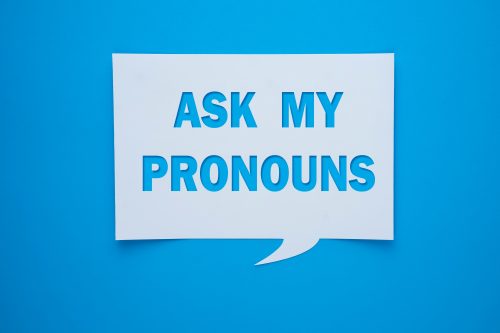
Pronoun Predicament?
Santo D. Marabella | Posted on |

This column was first published in the Reading Eagle on May 6, 2025.
When I originally considered how to approach this topic, I thought a thorough review of the development of pronoun use might be helpful. Then, I thought that I should present a succinct distillation of the issue from the pro-pronoun and anti-pronoun perspectives. But, all of that sounded like a dissertation and I’ve been there, done that, not doing it again!
I reflected more. I asked, “What is the real message I want to convey to readers?” That was a simple answer — respect without judgement.
The issue
So, what is the issue? As simply as I can put it — and this is by no means a comprehensive explanation — there are people who feel no, or not full, attachment to the gender assigned them at birth.
Before going further, it is helpful to note the difference between sex and gender identity. Sex is biological and physiological, usually male and female, you know along with the body parts we associate with each. Gender identity is the internal sense of being, which may or may not align with sex. This has nothing to do with sexual orientation, being gay or straight, etc., so don’t conflate the two.
Back to gender identity. A person may have been born male, but does not feel or live as a male, completely or partially. The same is true for some born female. They may consider themselves transgender (or trans). This means their gender identity does not correspond to the sex (male or female) registered to them at birth. In other instances, a person may consider themselves non-binary. This is a gender identity that does not conform to traditional binary beliefs about gender, which is you are either male or female. Nonbinary folks feel they are somewhere in between the two ends of the spectrum.
As a result, trans and nonbinary employees have preferred pronouns. If asked or permitted, they will share them. This may include: he/him, she/hers, they/them. They would prefer that you refer to them according to those pronouns.
This requires some work on our part. First, it requires some intentionality. You may have to deliberately think about which pronoun to use if their preferred pronoun doesn’t match what you think their gender identity is.
That leads to the second requirement — no judgement. It is irrelevant what you think their pronoun should be, or on what religious or society construct you choose to base your belief. Just as it is irrelevant who you think they should be allowed to marry or what nail polish color the guy in the next cubicle chooses to wear. You can have your feelings and judgements — we’re happy for you, just keep them to yourself. Their choice of pronouns has no impact on your ability to do your job with the same excellence and passion that you have always had (I’m giving grace here, accept it!).
Third, it can be confusing, especially if the person does not let you know. It’s okay to ask. Also, for me, using “they/them” for a singular person has been a challenge. I have struggled with this one because it seemed counter-intuitive — I was taught that “they” is a plural pronoun. Well, it is and it also has documented use as a singular pronoun. To help me, I consulted these sources (listed at the end of the column): Colleen Clemens “Thanks to the ‘Singular They’” and Emily Brewster’s NPR interview on The Definition of “they.” Perhaps they can help you?
Fourth, it requires empathy. Looking through the other person’s “lens” and seeing how it is for them — not how it would be for you. Feeling with them. Acknowledging them. This is about them.
Why it matters
So why does this matter? There is a lot of data, and a lot that is misleading or incomplete. Below are the most credible I could find:
• There are two million Americans who identify as transgender and about 1.3 million people who identify as nonbinary (McKinsey).
• Among Gen Z, under 29 years old and the newest generation in the workforce, 4.1% identify as trans, compared with 1.7% of millennials and less than 1% in each older generation (New York Times).
• Trans people are twice as likely to be unemployed, compared to cisgender — folks whose gender identity is aligned with their sex at birth. (McKinsey). You may be asking why? See the next bullet.
• More than 80% of transgender employees in the U.S. have experienced discrimination or harassment at work (UCLA Williams Institute).
If we still believe in treating people at work with respect, and I believe we do despite the gross disrespect we see from our national leaders, then using their preferred pronouns is a no-brainer. It costs nothing and it stands to gain you engagement, productivity and profit!
Inspired by the “Queen of Soul,” but tweaked a bit for our context, here’s our mantra for the day! “All I’m askin’ is for a little respect when I get to work (just a little bit).”
Santo D. Marabella
He/Him
Next Column: Raise Your Voice…At Work!
Dr. Santo D. Marabella, The Practical Prof, is a professor emeritus of management at Moravian University and hosts the podcast “Office Hours with The Practical Prof … and Friends.” His latest book, “The Lessons of Caring” is written to inspire and support caregivers (available in paperback and eBook). Website: ThePracticalProf.com; Twitter: @PracticalProf; Facebook: ThePracticalProf.
SOURCES & FURTHER READING:
Emily Brewster. The Definition of “They.” (2019, September 22).
Colleen Clemens. February 25, 2016. Thanks to the “Singular ‘They.’”.
McKinsey’s Being Transgender at Work
Nearly One in 10 U.S. Adults Identifies as L.G.B.T.Q., Survey Finds.
